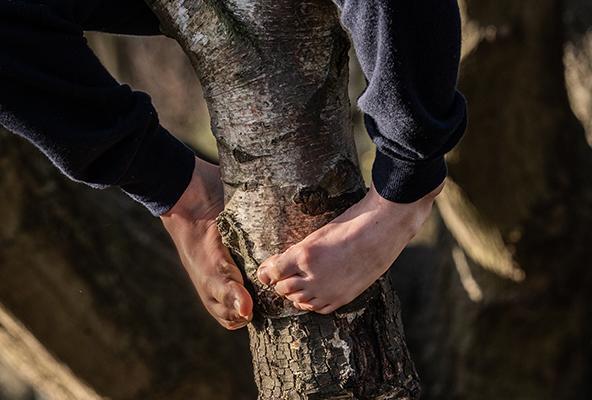WHAT IS ARCH SUPPORT AND DOES MY KID NEED IT?
Traditionally, ARCH SUPPORT was a key part of kids´ shoes. The old-fashioned idea was that a child´s foot needed help as it grew with a hard sole, support and cushioning round the ankle and, most importantly of all, ´arch support´.
The old-fashioned way of thinking was that, because babies and toddlers are born with flat feet, as they grow, the arches in their feet needed help developing, hence their arches needed propping up on the inside of their shoes.
But this theory was adhered to long after it didn´t appear to work very well. After all, flat feet, fallen arches, toes bunching together… all sorts of foot and ankle problems still sends kids to podiatrists for expensive orthotic cures; everything from inserts to special shoes, braces and sometimes even operations.
And if feet make it through childhood – there´s still adulthood to contend with.
77% of American adults suffer from some kind of debilitating foot issue, with women - consistently wearing pointier, narrower, more heeled shoes - four times as likely as men to live with some kind of foot pain. Painful feet affect our ability to move and be physical, and as our societies become ever more sedentary, physical inactivity is becoming an international health crisis.
But what if the problem isn´t our feet but the shoes we put kids in from the day they start walking – then no wonder so many of us end up with compromised, painful feet.
Let´s consider THE PROBLEM WITH SHOES.
Our feet have been evolving to live barefoot in a host of difficult terrains for several millenia, it would be a pretty significant system fail if our feet were so chronically weak.
Truth is, they´re not.
They´re just stuffed into inadequate shoe boxes that prevent them growing strong and healthy – and the science backs this up.
When we compare the feet of regularly shod and unshod kids, those who grow up largely barefoot have wider feet, a sign of overall foot strength, as well as presenting with fewer foot and toe deformities and lower instances of hallux valgus deformities (the protrusion of the bone that leads to bunions).
A recent study by two universities in South Africa and Germany found regularly barefoot kids (the South Africans) also scored better on balance and motor skills than their shod counterparts in Germany.
As podiatrist Dr. William A. Rossi writes, “It took 4 million years to develop our unique human foot and our distinctive form of gait… in only a few thousand years, and with one carelessly designed instrument, our shoes, we have warped the pure anatomical form of human gait, obstructing its engineering efficiency, afflicting it with strains and stresses and denying it its natural grace of form and ease of movement head to foot.”
SO how does being barefoot help feet grow stronger?
Babies are born with flat (adorable!) feet; kids’ arches develop over time and as the foot grows, so do its bones, muscles and tendons. If these are kept bunched up and unable to move, flex, tense and spring – it´s like the foot is trying to grow in a restrictive cast.
This is especially the case with arch support.
An arch is actually one of the strongest construction shapes possible – just look an at ancient stone bridge! The arches act like springs inside the foot, designed to ´load´ and ´unload´ with each step, with intrinsic muscles and ligaments providing all the support and elastic recoil it needs. Put a bunch of padding under the arch to support it, and you remove this loading/unloading action.
And just like any complex muscle system – use it or lose it. If arches get too much EXTERNAL support, they lose their own INTERNAL support system
And hello to fallen arches, doctors, expensive orthotics, lifetime of compromised movement.
And being barefoot isn´t just helping babies´ and kids´ growing bodies, but also how they use their blossoming physicality. Dr. Kacie Flegal, who specializes in pediatrics, writes, “One of the simplest ways to motivate proprioceptive and vestibular development is to let our babies be barefoot as much as possible.”
Which is quite the opposite of what happens in a traditional shoe that is all about padding, stiffness and support.
So the solution starts with us and how we help our kids grow – by letting them go barefoot as much as possible so their feet grow strong, flexible and wide for balanced and skilful movement. And, for when shoes are necessary, we think footwear should provide minimal interference in the foot doing its natural thing: no arch support, no padding, just the bare minimum a foot needs so as to be protected only from climate and terrain.
Somewhat 95% of babies are, after all, born with the potential to grow happy, healthy feet. We want to keep it that way.
Why being barefoot is good for kids´ developing nervous and vestibular systems:
Studies of habitually barefoot / shod feet and modern / ancient feet:
German / South African study comparing habitually shod / unshod feet:
https://www.ncbi.nlm.nih.gov/pmc/articles/PMC5010736/
German / South African study comparing motor skills and coordination of the habitually shod / unshod:
https://www.ncbi.nlm.nih.gov/pmc/articles/PMC5996942/
Article by a Doctor recommending orthotics (on compromised as well as injured feet):
https://www.health.harvard.edu/blog/do-i-need-orthotics-what-kind-2018102915182
Percentage of Americans suffering from debilitating foot pain:

